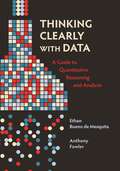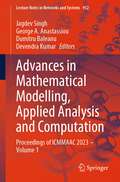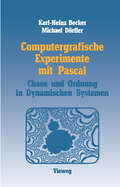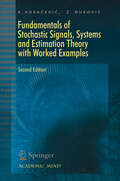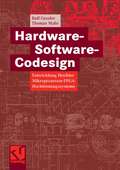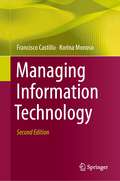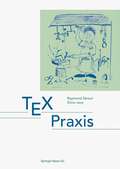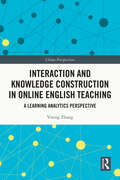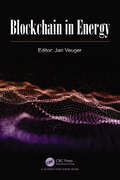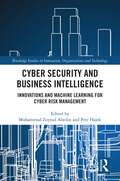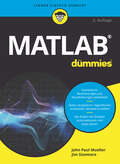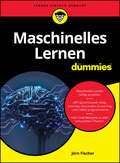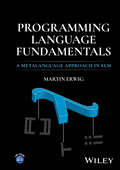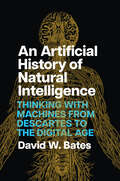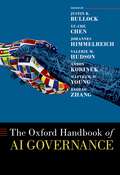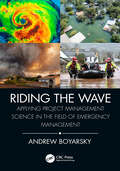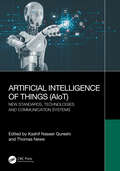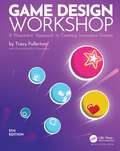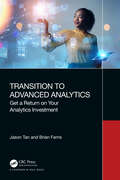- Table View
- List View
Thinking Clearly with Data: A Guide to Quantitative Reasoning and Analysis
by Ethan Bueno de Mesquita Anthony FowlerAn engaging introduction to data science that emphasizes critical thinking over statistical techniquesAn introduction to data science or statistics shouldn’t involve proving complex theorems or memorizing obscure terms and formulas, but that is exactly what most introductory quantitative textbooks emphasize. In contrast, Thinking Clearly with Data focuses, first and foremost, on critical thinking and conceptual understanding in order to teach students how to be better consumers and analysts of the kinds of quantitative information and arguments that they will encounter throughout their lives.Among much else, the book teaches how to assess whether an observed relationship in data reflects a genuine relationship in the world and, if so, whether it is causal; how to make the most informative comparisons for answering questions; what questions to ask others who are making arguments using quantitative evidence; which statistics are particularly informative or misleading; how quantitative evidence should and shouldn’t influence decision-making; and how to make better decisions by using moral values as well as data. Filled with real-world examples, the book shows how its thinking tools apply to problems in a wide variety of subjects, including elections, civil conflict, crime, terrorism, financial crises, health care, sports, music, and space travel.Above all else, Thinking Clearly with Data demonstrates why, despite the many benefits of our data-driven age, data can never be a substitute for thinking.An ideal textbook for introductory quantitative methods courses in data science, statistics, political science, economics, psychology, sociology, public policy, and other fieldsIntroduces the basic toolkit of data analysis—including sampling, hypothesis testing, Bayesian inference, regression, experiments, instrumental variables, differences in differences, and regression discontinuityUses real-world examples and data from a wide variety of subjectsIncludes practice questions and data exercises
Advances in Mathematical Modelling, Applied Analysis and Computation: Proceedings Of Icmmaac 2022 (Lecture Notes In Networks And Systems Ser. #666)
by Jagdev Singh George A. Anastassiou Dumitru Baleanu Devendra KumarComputergrafische Experimente mit Pascal: Ordnung und Chaos in Dynamischen Systemen
by Karl-Heinz Becker Michael DörflerFundamentals of Stochastic Signals, Systems and Estimation Theory: With worked Examples
by Branko Kovacevic Zeljko DurovicHardware-Software-Codesign: Entwicklung flexibler Mikroprozessor-FPGA-Hochleistungssysteme
by Ralf Gessler Thomas MahrInteraction and Knowledge Construction in Online English Teaching: A Learning Analytics Perspective (ISSN)
by Yining ZhangWithin a Chinese English as a Foreign Language (EFL) learning context, this book investigates how teachers and learners interacted and articulated their understanding of English for Research Publication Purposes (ERPP)-related knowledge in a synchronous EFL classroom.The outbreak of the COVID-19 pandemic changed the way people receive education, causing an almost overnight switch from on-campus instruction to distance learning. Under the use of three different learning analytics approaches, this book has moved beyond the usual descriptive understanding of the online learning process to an in-depth exploratory and inferential analysis of the entities, structures, relations, and processes of learning. The findings enrich current understandings of the complexity of ERPP teaching and learning in synchronous learning contexts. These findings also drive us to rethink and reshape the way ERPP instruction is delivered post-pandemic.An essential read for students and scholars of education and academic English. This book will also be a vital source for researchers in the field of learning analytics, data analysis, and data interpretation in language teaching and learning.
Blockchain in Energy
by Jan VeugerThe global energy crisis is accelerating, and within Europe, the European Union (EU) is actively working to address this challenge through policy frameworks and political management. However, the energy market remains fiercely competitive, prompting us to explore alternative energy sources and rethink how we generate, distribute, and utilize power. This, in turn, raises questions about the allocation of power, energy availability, and usage in various contexts.Furthermore, the digital realm is undergoing rapid transformation across multiple sectors. Drawing on my expertise in blockchain technology, I recognize numerous opportunities to enhance the transparency and reliability of data related to energy issues. By leveraging blockchain, we can ensure that the information available is trustworthy and insightful for every user.The aim of this book is to share my knowledge in the realm of energy and blockchain. It addresses the urgency of addressing global energy challenges and acknowledges the pivotal role of the EU in this endeavor. It also highlights the intensity of competition in the energy market and the need for innovative approaches. The book also demonstrates how blockchain can contribute to solving these issues, empowering individuals and organizations with reliable information and insights in the field of energy and blockchain technology.
Cyber Security and Business Intelligence: Innovations and Machine Learning for Cyber Risk Management (Routledge Studies in Innovation, Organizations and Technology)
by Mohammad Zoynul Abedin Petr HajekTo cope with the competitive worldwide marketplace, organizations rely on business intelligence to an increasing extent. Cyber security is an inevitable practice to protect the entire business sector and its customer. This book presents the significance and application of cyber security for safeguarding organizations, individuals’ personal information, and government.The book provides both practical and managerial implications of cyber security that also supports business intelligence and discusses the latest innovations in cyber security. It offers a roadmap to master degree students and PhD researchers for cyber security analysis in order to minimize the cyber security risk and protect customers from cyber-attack. The book also introduces the most advanced and novel machine learning techniques including, but not limited to, Support Vector Machine, Neural Networks, Extreme Learning Machine, Ensemble Learning, and Deep Learning Approaches, with a goal to apply those to cyber risk management datasets. It will also leverage real-world financial instances to practise business product modelling and data analysis.The contents of this book will be useful for a wide audience who are involved in managing network systems, data security, data forecasting, cyber risk modelling, fraudulent credit risk detection, portfolio management, and data regulatory bodies. It will be particularly beneficial to academics as well as practitioners who are looking to protect their IT system, and reduce data breaches and cyber-attack vulnerabilities.
Matlab für Dummies (Für Dummies)
by Jim Sizemore John Paul MuellerMATLAB® So lernen Sie MATLAB ideal zu nutzen Ob Naturwissenschaftler, Mathematiker, Ingenieur oder Datenwissenschaftler - mit MATLAB haben Sie ein mächtiges Tool in der Hand, das Ihnen die Arbeit mit Ihren Daten erleichtert. Aber wie das mit manch mächtigen Dingen so ist - es ist auch ganz schön kompliziert. Aber keine Sorge! Die Autoren führen Sie in diesem Buch Schritt für Schritt an das Programm heran - von der Installation und den ersten Skripten bis hin zu aufwändigen Berechnungen, der Erstellung von Grafiken und effizienter Fehlerbehebung. Sie werden begeistert sein, was Sie mit MATLAB alles anstellen können. Sie erfahren Was es mit dem MATLAB-Dateisystem auf sich hat Wie Sie mathematische Operationen mit Vektoren und Matrizen durchführen Wie Sie Funktionen und Skripte erstellen Wie Sie importieren, exportieren und publizieren.
Maschinelles Lernen für Dummies (Für Dummies)
by Jörn FischerAlgorithmen für künstliches Lernen verstehen Maschinelles Lernen ist eines der wichtigsten Teilgebiete der künstlichen Intelligenz und das Verstehen und Entwickeln von passenden Algorithmen bleibt die große Herausforderung. Dieses Buch bietet einen außergewöhnlich umfassenden Überblick über die neuesten Algorithmen und die bereits bewährten Verfahren. Jörn Fischer beschreibt nicht nur deren Funktionsweise, sondern gibt für alle Bereiche verständliche Beispiele, die detailliert beschrieben und leicht nachvollziehbar sind. Außerdem werden hilfreiche Methoden zur Fehlersuche und -beseitigung an die Hand gegeben. Sie erfahren Wie Sie mit Python und Frameworks starten Wie Sie Optimierung, Clustering und Klassifizierung umsetzen Wie generative Methoden und Reinforcement Learning funktionieren Wie neuronale Netze arbeiten und erklärbar werden
Programming Language Fundamentals: A Metalanguage Approach in Elm
by Martin ErwigPROGRAMMING LANGUAGE FUNDAMENTALS Understand the key principles of programming languages Programming languages are the tools needed to let algorithms run on electronic computers. As they form the linguistic interface between humans and machines, the understanding of programming languages is essential for being able to control machine behavior. Programming Language Fundamentals offers a precise, comprehensive introduction to the principles that are the basis of most programming languages. Explaining both functional programming and logic programming, it presents a broad perspective on programming and constitutes an indispensable introduction to the foundations of programming languages. Programming Language Fundamentals readers will also find: Introduction to Elm as a metalanguage to encourage thinking and experimenting with programming languages in a formal way Detailed discussion of topics including abstract syntax, semantics, types, and more In-depth explanations of key concepts such as scope and parameter passing Programming Language Fundamentals is ideal for undergraduate students in computer science, as well as researchers and practitioners working with programming languages who are looking to broaden their understanding of the field.
An Artificial History of Natural Intelligence: Thinking with Machines from Descartes to the Digital Age
by David W. BatesA new history of human intelligence that argues that humans know themselves by knowing their machines. We imagine that we are both in control of and controlled by our bodies—autonomous and yet automatic. This entanglement, according to David W. Bates, emerged in the seventeenth century when humans first built and compared themselves with machines. Reading varied thinkers from Descartes to Kant to Turing, Bates reveals how time and time again technological developments offered new ways to imagine how the body’s automaticity worked alongside the mind’s autonomy. Tracing these evolving lines of thought, An Artificial History of Natural Intelligence offers a new theorization of the human as a being that is dependent on technology and produces itself as an artificial automaton without a natural, outside origin.
An Artificial History of Natural Intelligence: Thinking with Machines from Descartes to the Digital Age
by David W. BatesA new history of human intelligence that argues that humans know themselves by knowing their machines. We imagine that we are both in control of and controlled by our bodies—autonomous and yet automatic. This entanglement, according to David W. Bates, emerged in the seventeenth century when humans first built and compared themselves with machines. Reading varied thinkers from Descartes to Kant to Turing, Bates reveals how time and time again technological developments offered new ways to imagine how the body’s automaticity worked alongside the mind’s autonomy. Tracing these evolving lines of thought, An Artificial History of Natural Intelligence offers a new theorization of the human as a being that is dependent on technology and produces itself as an artificial automaton without a natural, outside origin.
The Oxford Handbook of AI Governance (Oxford Handbooks)
As the capabilities of Artificial Intelligence (AI) have increased over recent years, so have the challenges of how to govern its usage. Consequently, prominent stakeholders across academia, government, industry, and civil society have called for states to devise and deploy principles, innovative policies, and best practices to regulate and oversee these increasingly powerful AI tools. Developing a robust AI governance system requires extensive collective efforts throughout the world. It also raises old questions of politics, democracy, and administration, but with the new challenges posed by AI's growing influence on markets, governing structures, international relations, healthcare, science, and political activism. The Oxford Handbook of AI Governance delineates the scope of these issues and addresses the key questions of AI governance. Across forty-nine chapters, organized in nine major sections, the Handbook covers the theoretical and ethical foundations of AI governance, different frameworks for developing a governance structure for AI, practical perspectives on AI governance in different policy domains, economic analyses of AI governance, and concrete lessons about the impact of AI governance domestically and internationally. Chapter authors come from a wide set of disciplines, areas of study, and cultural backgrounds, providing a global perspective on AI governance.
The Oxford Handbook of AI Governance (Oxford Handbooks)
by Justin B. Bullock, Yu-Che Chen, Johannes Himmelreich, Valerie M. Hudson, Anton Korinek, Matthew M. Young and Baobao ZhangAs the capabilities of Artificial Intelligence (AI) have increased over recent years, so have the challenges of how to govern its usage. Consequently, prominent stakeholders across academia, government, industry, and civil society have called for states to devise and deploy principles, innovative policies, and best practices to regulate and oversee these increasingly powerful AI tools. Developing a robust AI governance system requires extensive collective efforts throughout the world. It also raises old questions of politics, democracy, and administration, but with the new challenges posed by AI's growing influence on markets, governing structures, international relations, healthcare, science, and political activism. The Oxford Handbook of AI Governance delineates the scope of these issues and addresses the key questions of AI governance. Across forty-nine chapters, organized in nine major sections, the Handbook covers the theoretical and ethical foundations of AI governance, different frameworks for developing a governance structure for AI, practical perspectives on AI governance in different policy domains, economic analyses of AI governance, and concrete lessons about the impact of AI governance domestically and internationally. Chapter authors come from a wide set of disciplines, areas of study, and cultural backgrounds, providing a global perspective on AI governance.
Riding the Wave: Applying Project Management Science in the Field of Emergency Management (ISSN)
by Andrew BoyarskyEmergency managers and public safety professionals are more frequently being called on to address increasingly challenging and complex critical incidents, with a wider variety and intensity of hazards, threats, and community vulnerabilities. Much of the work that falls into the scope of emergency managers – prevention, preparedness, mitigation – is “blue sky planning” and can be contained and effectively managed within projects. This book provides a foundational project management methodology relevant to emergency management practice, and explains and demonstrates how project management can be applied in the context of emergency and public safety organizations.Special features include: an initial focus on risk assessment and identification of mitigation and response planning measures; a clear set of better practices, using a diverse set of examples relevant to today’s emergency environment, from projects to develop emergency response exercises to application development to hazard mitigation; a framework for managing projects at a strategic level and how to incorporate this into an organization’s program, and presents how to develop and manage an emergency program and project portfolio; and suitability as both a hands-on training guide for emergency management programs and a textbook for academic emergency management programs. This book is intended for emergency managers and public safety professionals who are responsible for developing emergency programs and plans, including training courses, job aids, computer applications and new technology, developing exercises, and for implementing these plans and components in response to an emergency event. This audience includes managers in emergency and first response functions such as fire protection, law enforcement and public safety, emergency medical services, public health and healthcare, sanitation, public works, business continuity managers, crisis managers, and all managers in emergency support functions as described by FEMA. This would include those who have responsibility for emergency management functions, even without the related title.
Riding the Wave: Applying Project Management Science in the Field of Emergency Management (ISSN)
by Andrew BoyarskyEmergency managers and public safety professionals are more frequently being called on to address increasingly challenging and complex critical incidents, with a wider variety and intensity of hazards, threats, and community vulnerabilities. Much of the work that falls into the scope of emergency managers – prevention, preparedness, mitigation – is “blue sky planning” and can be contained and effectively managed within projects. This book provides a foundational project management methodology relevant to emergency management practice, and explains and demonstrates how project management can be applied in the context of emergency and public safety organizations.Special features include: an initial focus on risk assessment and identification of mitigation and response planning measures; a clear set of better practices, using a diverse set of examples relevant to today’s emergency environment, from projects to develop emergency response exercises to application development to hazard mitigation; a framework for managing projects at a strategic level and how to incorporate this into an organization’s program, and presents how to develop and manage an emergency program and project portfolio; and suitability as both a hands-on training guide for emergency management programs and a textbook for academic emergency management programs. This book is intended for emergency managers and public safety professionals who are responsible for developing emergency programs and plans, including training courses, job aids, computer applications and new technology, developing exercises, and for implementing these plans and components in response to an emergency event. This audience includes managers in emergency and first response functions such as fire protection, law enforcement and public safety, emergency medical services, public health and healthcare, sanitation, public works, business continuity managers, crisis managers, and all managers in emergency support functions as described by FEMA. This would include those who have responsibility for emergency management functions, even without the related title.
Artificial Intelligence of Things (AIoT): New Standards, Technologies and Communication Systems
by Kashif Naseer Qureshi Thomas NeweThis book is devoted to the new standards, technologies, and communication systems for Artificial Intelligence of Things (AIoT) networks. Smart and intelligent communication networks have gained significant attention due to the combination of AI and IoT networks to improve human and machine interfaces and enhance data processing and services. AIoT networks involve the collection of data from several devices and sensor nodes in the environment. AI can enhance these networks to make them faster, greener, smarter, and safer. Computer vision, language processing, and speech recognition are some examples of AIoT networks.Due to a large number of devices in today’s world, efficient and intelligent data processing is essential for problem-solving and decision-making. AI multiplies the value of these networks and promotes intelligence and learning capabilities, especially in homes, offices, and cities. However, several challenges have been observed in deploying AIoT networks, such as scalability, complexity, accuracy, and robustness. In addition, these networks are integrated with cloud, 5G networks, and blockchain methods for service provision. Many different solutions have been proposed to address issues related to machine and deep learning methods, ontology-based approaches, genetic algorithms, and fuzzy-based systems.This book aims to contribute to the state of the art and present current standards, technologies, and approaches for AIoT networks. This book focuses on existing solutions in AIoT network technologies, applications, services, standards, architectures, and security provisions. This book also introduces some new architectures and models for AIoT networks.
Artificial Intelligence of Things (AIoT): New Standards, Technologies and Communication Systems
This book is devoted to the new standards, technologies, and communication systems for Artificial Intelligence of Things (AIoT) networks. Smart and intelligent communication networks have gained significant attention due to the combination of AI and IoT networks to improve human and machine interfaces and enhance data processing and services. AIoT networks involve the collection of data from several devices and sensor nodes in the environment. AI can enhance these networks to make them faster, greener, smarter, and safer. Computer vision, language processing, and speech recognition are some examples of AIoT networks.Due to a large number of devices in today’s world, efficient and intelligent data processing is essential for problem-solving and decision-making. AI multiplies the value of these networks and promotes intelligence and learning capabilities, especially in homes, offices, and cities. However, several challenges have been observed in deploying AIoT networks, such as scalability, complexity, accuracy, and robustness. In addition, these networks are integrated with cloud, 5G networks, and blockchain methods for service provision. Many different solutions have been proposed to address issues related to machine and deep learning methods, ontology-based approaches, genetic algorithms, and fuzzy-based systems.This book aims to contribute to the state of the art and present current standards, technologies, and approaches for AIoT networks. This book focuses on existing solutions in AIoT network technologies, applications, services, standards, architectures, and security provisions. This book also introduces some new architectures and models for AIoT networks.
Game Design Workshop: A Playcentric Approach to Creating Innovative Games
by Tracy Fullerton“Create the digital games you love to play.”Discover an exercise-driven, non-technical approach to game design without the need for programming or artistic experience with Game Design Workshop, Fifth Edition.Tracy Fullerton demystifies the creative process with clear and accessible guidance on the formal, dramatic, and dynamic systems of game design. Using examples of classic and popular games, illustrations of design techniques, and refined exercises to strengthen your understanding of how game systems function, this book gives you the skills and tools necessary to create a compelling and engaging game.This updated 5th edition brings deeper coverage of playcentric design techniques, including setting emotion-focused experience goals and managing the design process to meet them. It includes a host of new diverse perspectives from top industry game designers.Game Design Workshop puts you to work prototyping, playtesting, and revising your own games with time-tested methods and tools. These skills will provide the foundation for your career in any facet of the game industry including design, producing, programming, and visual design.
Game Design Workshop: A Playcentric Approach to Creating Innovative Games
by Tracy Fullerton“Create the digital games you love to play.”Discover an exercise-driven, non-technical approach to game design without the need for programming or artistic experience with Game Design Workshop, Fifth Edition.Tracy Fullerton demystifies the creative process with clear and accessible guidance on the formal, dramatic, and dynamic systems of game design. Using examples of classic and popular games, illustrations of design techniques, and refined exercises to strengthen your understanding of how game systems function, this book gives you the skills and tools necessary to create a compelling and engaging game.This updated 5th edition brings deeper coverage of playcentric design techniques, including setting emotion-focused experience goals and managing the design process to meet them. It includes a host of new diverse perspectives from top industry game designers.Game Design Workshop puts you to work prototyping, playtesting, and revising your own games with time-tested methods and tools. These skills will provide the foundation for your career in any facet of the game industry including design, producing, programming, and visual design.
Transition to Advanced Analytics: Get a Return on Your Analytics Investment
by Jason Tan Brian FerrisAmazon knows the products we’re interested in and shows us more to boost the size of our shopping cart. Google Maps knows the best route to get from A to B and recommends it to get us there in the shortest possible time. Netflix knows the media we enjoy most and recommends more to boost streaming time. However, many companies still fall short with their data analytics practices.This book focuses on how to embed advanced analytics directly into daily business operations and complement an enterprise system. This book can guide you in how traditional industries like retailers, banks and insurers can utilise and develop advanced analytics complementing their enterprise systems while embedding advanced analytics directly to optimise revenue and customer experience. Detailed in this book is a world-class analytics application used by loyalty point providers, banks, insurers and leading retailers.The title also provides a step-by-step implementation framework for Chief Digital and Artificial Intelligence Offices to develop their advanced analytics capabilities in tandem with legacy IT systems.
Transition to Advanced Analytics: Get a Return on Your Analytics Investment
by Jason Tan Brian FerrisAmazon knows the products we’re interested in and shows us more to boost the size of our shopping cart. Google Maps knows the best route to get from A to B and recommends it to get us there in the shortest possible time. Netflix knows the media we enjoy most and recommends more to boost streaming time. However, many companies still fall short with their data analytics practices.This book focuses on how to embed advanced analytics directly into daily business operations and complement an enterprise system. This book can guide you in how traditional industries like retailers, banks and insurers can utilise and develop advanced analytics complementing their enterprise systems while embedding advanced analytics directly to optimise revenue and customer experience. Detailed in this book is a world-class analytics application used by loyalty point providers, banks, insurers and leading retailers.The title also provides a step-by-step implementation framework for Chief Digital and Artificial Intelligence Offices to develop their advanced analytics capabilities in tandem with legacy IT systems.
